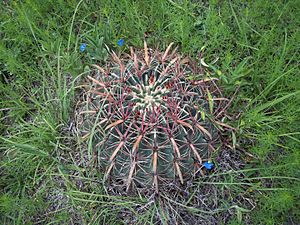Ferocactus latispinus facts for kids
Quick facts for kids Ferocactus latispinus |
|
|---|---|
 |
|
| Ferocactus latispinus in flower | |
| Scientific classification | |
| Genus: |
Ferocactus
|
| Species: |
latispinus
|
| Synonyms | |
|
|
The Ferocactus latispinus is a cool type of barrel cactus that grows naturally in Mexico. It's sometimes called the Devil's Tongue Barrel or Crow's Claw Cactus. This plant got its first scientific name, Cactus latispinus, in 1824 from an English scientist named Adrian Hardy Haworth. Later, in 1922, two American botanists, Britton and Rose, gave it its current name when they created the Ferocactus group. The name lati-spinus comes from Latin words meaning "broad" and "spine", which describes its wide spines.
Contents
Where Does This Cactus Grow?

This cactus is special because it only grows in Mexico. The most common type, called latispinus, can be found in many states. These include southeastern Durango, Zacatecas, Aguascalientes, and parts of San Luis Potosí, Hidalgo, and Puebla. You can also find it in eastern Jalisco, Guanajuato, Querétaro, and Mexico State.
Another type, called spiralis, only grows in the southern parts of Oaxaca and Puebla. You'll often find these cacti growing under bigger plants like trees or shrubs. These "nurse plants" help protect the smaller cacti from harsh weather. They give them shade in hot, sunny places.
What Does the Cactus Look Like?
The Ferocactus latispinus grows as a single, round cactus. It's usually a light green color. It can grow up to 30 centimeters (about 12 inches) tall and 40 centimeters (about 16 inches) wide. It has 21 sharp ridges along its body.
Its spines can be reddish or white. They are flat and can be as long as 4 or 5 centimeters. This cactus blooms in late autumn or early winter. Its flowers are shaped like funnels and can be purple or yellowish. They grow up to 4 centimeters long. After the flowers, the cactus grows oval-shaped fruits with scales. These fruits can be about 2.5 centimeters (1 inch) long.
Different Types of This Cactus
There are two main types, or subspecies, of Ferocactus latispinus. They are different because of how many radial spines they have. Radial spines are the ones that stick out from the sides.
- Ferocactus latispinus subsp. latispinus: This type has 9 to 15 radial spines. It's known as the Devil's Tongue Barrel or Crow's Claw Cactus.
- Ferocactus latispinus subsp. spiralis: This type has fewer radial spines, usually 5 to 7.
Growing This Cactus at Home
The Ferocactus latispinus is a popular plant to grow in gardens. It's a good choice because it starts to bloom flowers when it's still young. This makes it a nice plant for people who like to grow cacti. It can handle cold temperatures down to about -4 degrees Celsius (25 degrees Fahrenheit). But it prefers warmer temperatures, usually around 10 degrees Celsius (50 degrees Fahrenheit) or higher.
An interesting fact is that a type of slime mold called Didymium wildpretii actually feeds on the dead parts of F. latispinus in Mexico.
See also
 In Spanish: Ferocactus latispinus para niños
In Spanish: Ferocactus latispinus para niños

